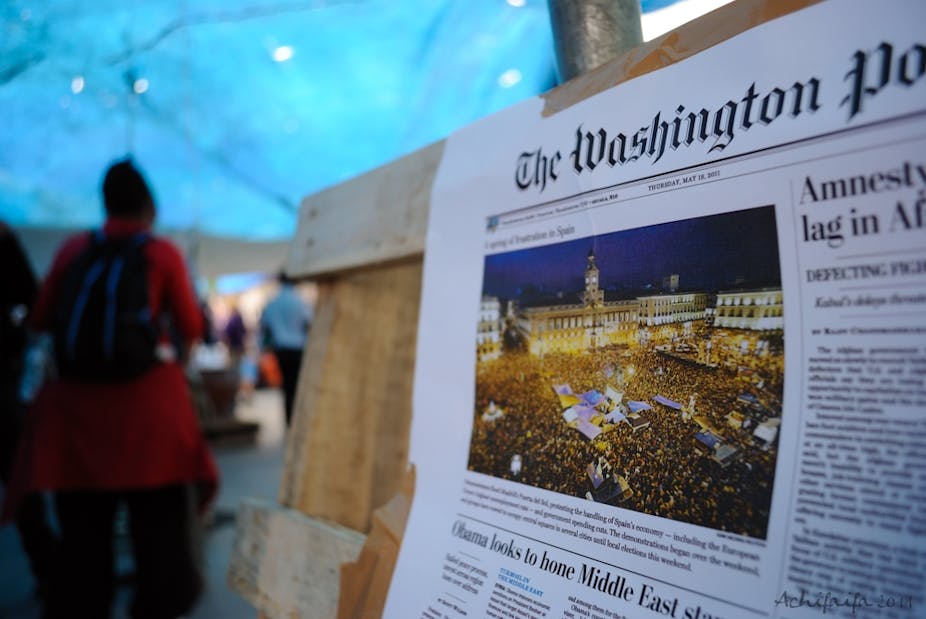Perhaps the proverbial tipping point in US print journalism has been reached. With the US$250m acquisition this week of The Washington Post by Amazon founder and billionaire Jeff Bezos, the US newspaper industry will fully accept it fought technology and technology has thankfully won.
When the web emerged back in the early 1990s, newspapers refused to embrace digital technology. The internet remained a mystery to most newsrooms and even when it was visualised in the web browser many rejected it, calling it a passing fad.
When newspapers did begin to accept the online world, it often was a confused, “not in my neighborhood” approach. In fact, the Washington Post itself created a dot.com, but located its offices across the river from its headquarters rather than start with immediate integration of online and print.
Newspapers’ misunderstanding also led them to charge for the hardcopy while giving the content away free on their websites and to Google, Yahoo and host of other news aggregators. And it was an industry that put little or no money into technology and data analysis training.
“Even a valuable product, however, can self-destruct from a faulty business strategy …” legendary investor Warren Buffett has said, noting publishers “ … have offered their paper free on the internet while charging meaningful sums for the physical specimen. How could this lead to anything other than a sharp and steady drop in sales of the printed product?”
In 1994 meanwhile, in a parallel universe, Jeff Bezos saw the web and saw the future. He left his job in finance and began the classic out-of-his-garage venture that became the retail behemoth Amazon.com.
So this week, two decades later, the universes finally merged and the digital Bezos bought the declining Post from the Graham family.
Many traditional newspaper folk in the US say they are shocked by the sale. They fear for the future of journalism and they are worried about a hidden political agenda. But if there is any shock, it is that there is hope – hope, because those with money are investing in newsrooms again.
Last week a local business group led by John Henry, better known as a sports team owner, bought the Boston Globe and other newspapers for a bargain. Buffett’s company Berkshire Hathaway has been scooping up local and community newspapers throughout the nation for the past year. (Buffett has also profited nicely from the Post sale.)
The right-wing billionaire Koch brothers have been considering buying the Tribune papers, a collection of ten daily newspapers including the Chicago Tribune and the Los Angeles Times.
And there is talk that when New York City Mayor Michael Bloomberg gets out of office he may make the Sulzberger family an offer for the New York Times they can’t refuse. Bloomberg, another billionaire, already owns the profitable Bloomberg News.
Until these recent purchases, the primary business model has been one of plunges in news quality and the “harvesting” of profits from what is perceived as a dying industry. In the past decade, nearly a third of editorial print jobs – 18,000 out of 56,000 – have disappeared from newspapers, according to a study released last month.
And it continues. In the past weeks Gannett, owner of USA Today and a host of local papers, laid off dozens more and the Plain Dealer in Cleveland cut a third of its newsroom staff.
The result is that coverage at US newspapers has been reduced to reporters rushing to write quick stories, take photos and fire off blog updates while owners hope for citizen journalists (previously known as unpaid stringers) to fill the gaps. And staffing at state capitols and foreign bureaus is nearly non-existent.
But the purchase of the Post may be the most prominent signal in the turnaround of the news industry in the US. We could be witnessing the evolution of a leaner, more focused digital business model that merges various delivery systems and makes content more targeted and meaningful.
Henry Blodget, whose site Business Insider was bought by Bezos last year, sent out the message of hope last week in what some saw as an overly optimistic column. He said the sustaining digital business model had been found. As evidence of his point, he cited the hundreds of millions of dollars that the New York Times has gained in digital advertising.
Whether Blodget is right, it appears the smart money has waited until the corporations and families have mismanaged the newspapers to fire-sale prices, digital ad revenue has increased substantially and customers have started to pay subscriptions for content on the web.
As Buffett, one of these “smart money” investors, has said:
… Papers delivering comprehensive and reliable information to tightly-bound communities and having a sensible internet strategy will remain viable for a long time. We do not believe that success will come from cutting either the news content or frequency of publication.
So unlike the previous generation of newspaper owners, the new investors see a future in quality. And this might just mean a quality future for newspapers.

